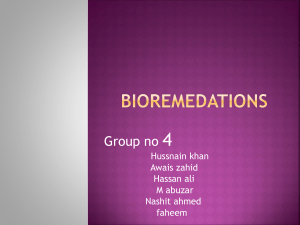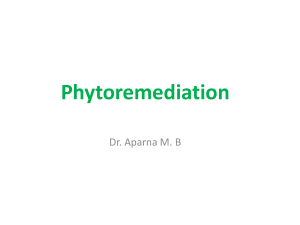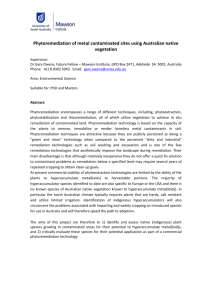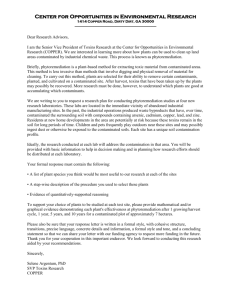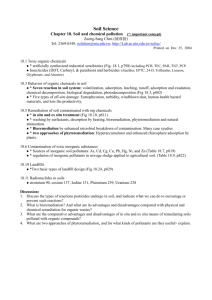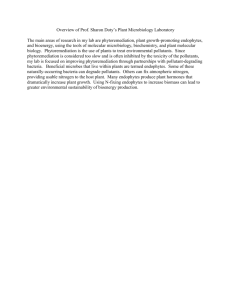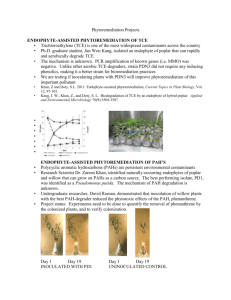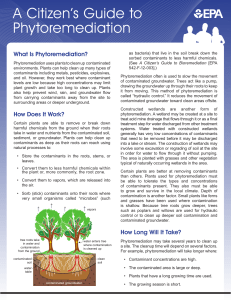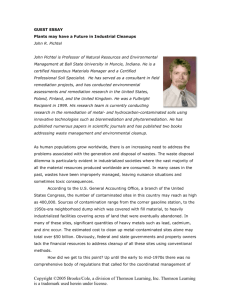Introduction
advertisement
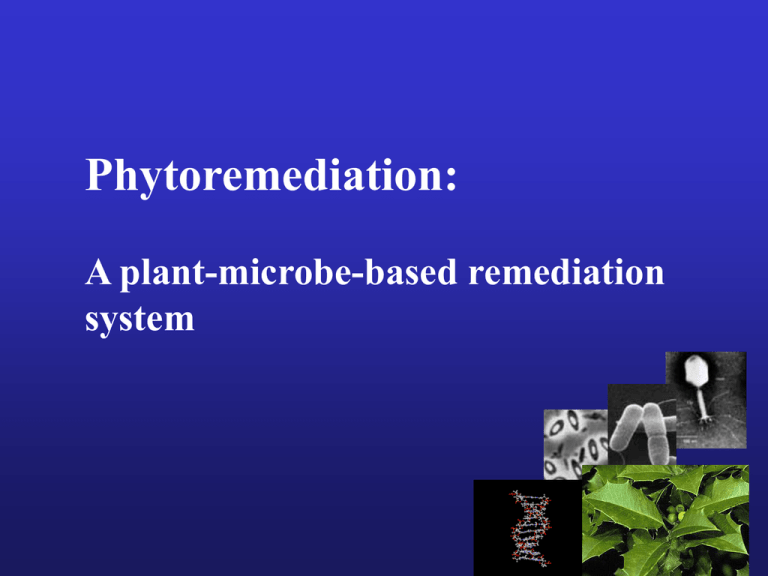
Phytoremediation: A plant-microbe-based remediation system Introduction • Rational • Economic potential • Public acceptance and regulatory considerations Principles of phytoremediaiton Phytoremediaiton of heavy metals Phytoremediation of organics Phytoremediation— Refers to the use of green or vascular plants for removal of organic and inorganic contaminants. It may be applied to: • • • • • Phytoextraction Phytostabilization Phytofiltration Phytovolatilization Phytodegradation Phytoextraction The use of metalaccumulating plants that can transport and concentrate metals from the soil to the roots and aboveground shoots. • high biomass production • handling ease Cd • established cultivation practices To increase the efficiency of phytoextraction, e.g. addition of chelators to contaminated soil. As Cu Zn Pb Phytostabilization The use of plants to control the movement of water underground, or soil amendments are also applied to contaminated soil to reduce the bioavailability of the contaminants. Also termed as inplace inactivation or phytorestoration. • Effective in immobilizing watersoluble contamination and preventing migration • But it does not remove contaminants from the site. As PCBs 2,4-D TNT Pb H2O H2O H2O • The site is planted into vegetation, which reduces off site migration of the stabilized soil matrix and contaminant through water usage and erosion control. • Plant are chosen to maximize root uptake of contaminant and would sequester the material in the root tissue and potentially help catalyze the formation of insoluble contaminant species such as Pb-pyromorphite [3Pb3(PO4)2.PbCl2--lead phosphate chloride]. e.g. Fast-growing poplars with deep roots are able to absorb and transpire large quantities of water from the roots through shoots into the atmosphere. Hybrid Poplar Field at Edward Sears Property Rhizofiltration The use of plant roots to absorb, concentrate, and precipitate heavy metals from water. (1) The roots of sunflowers have been used to treat water containing lead, uranium, strontium, cesium, cobalt, and zinc to concentrations below the accepted water standards. (2) This approach has been used to remove uranium from groundwater on sites at Ashtabula, OH, and Oak Ridge, TN, and to remove cesium and strontium from a pond near the Chernobyl reactor. The presence of other metal ions does not substantially interfere with rhizofiltration of lead, cesium, or strontium, suggesting that this approach can be used to remove target metals from mixtures containing different metal ions Phytoremediation— Initially, the term has been closely associated with the potential use of hyperaccumulator species, plant being able to accumulate unusual levels of metals in their tissues. Recently, the scope has been extended to include other plant-based processes that result either in containments or removal of pollutants, e.g., immobilization, degradation and volatilization (Wenzel et al., 1999). Most of the hyperaccumulators are rather small herbaceous plants growing on naturally metalliferous sites or on old mining deposits. Because of the low-biomass limitation of hyperaccumulator species, high-biomass vegetation, such as trees and grass are being evaluated as an alternative, even though the bioconcentration of metals is typically well below that found in the former. Economic potential Based on Kruger et al., 1997, non-biobased remediation technology cost: in situ: $10 to $100 / m3 ex situ: $30 to $300 / m3 Specialized techniques such as in situ vitrification can easily surpass $1000/m3. In comparison: Land farming can be as low as $0.05/m3/year • Economical potential is the major driving force over agriculturally-based soil remediation. • Agricultural practices developed for soil management with its primary goal for maintaining soil quality have applicability in soil remediation. * * * * * * * * * Raskin and Ensley, 2000 International Market The US market account for 35 to 45% of the total world environmental spending. The size of the remediation market in the entire EU is just below half that of the US. However, the forces driving remediation markets in Europe tend to lag behind those of the US. Public acceptance and regulatory considerations What do you prefer in your neighborhood? Large earth-moving equipment and long-term exposure to dust and other air pollutants. vs. Orderly plots of plants, such as in the center of Trenton, NJ. Phytoremediation can start as a garden U.S. EPA’s mission: 1. Protect human health 2. Protect the environment The US EPT use 9 criteria to evaluate the alternatives and determine the remedy preference 1. 2. 3. 4. 5. 6. 7. 8. 9. Overall protection of human health and the environment Compliance with applicable or relevant and appropriate requirements Long-term effectiveness and permanence Reduction of contaminant toxicity, mobility, or volume through treatment. Short-term effectiveness Implementability Cost State acceptance Community acceptance In a Superfund site, it is the task of the US EPA RPM (remedial project manager) to choose a remedy and write the record of decision (ROD) for the site For the RPM to consider phytoremediation, at least three different assurances must be in place for final remedy selection: 1. Adequate containment of contaminated soils, groundwater, and sediments must be assured until the plants associated with phytoremediation have established themselves at the site to a point that they are either containing or degrading the contaminants of interests. 2. An adequate backup technology with a high chance of success must be ready and available to use at the site. 3. Evidence of the effectiveness of phytoremediation that is specific to the site matrix and contaminants must be presented.
